QoT aware load balancing routing in manet using relay type of amplify and forward based cooperative communications
In research topics to improve the performance of the mobile ad hoc networks (MANET),
the load balancing routing has attracted many research groups because it is an effective solution to
reduce traffic congestion. However, to balance the traffic load, the routing algorithm often has to
choose some long routes. These routes pass through many hops and intermediate nodes, so the
accumulated noise along with the route increases. As a result, the quality of transmission (QoT) of
data transmission routes decreases, especially in the case of MANET using the relay type of amplifyand-forward (AF), where the noise power can be amplified at intermediate nodes. Therefore, it is
necessary to study the QoT aware load balancing routing algorithms. In this paper, we focus on investigating the QoT in the MANET using AF and propose a load balancing routing algorithm under the
constraint of the QoT. The proposed algorithm is improved from the new route discovery algorithm
of the on-demand routing protocol. Our idea is to combine the operation of the route request and
reply packets to collect the information of the traffic load and QoT from source to destination, used
for the objective and the constraints of selecting a new route. Our evaluation by simulation method
has shown that the proposed algorithm can improve the network performance in terms of the QoT,
packet loss probability, and network throughput compared with the original routing algorithms.
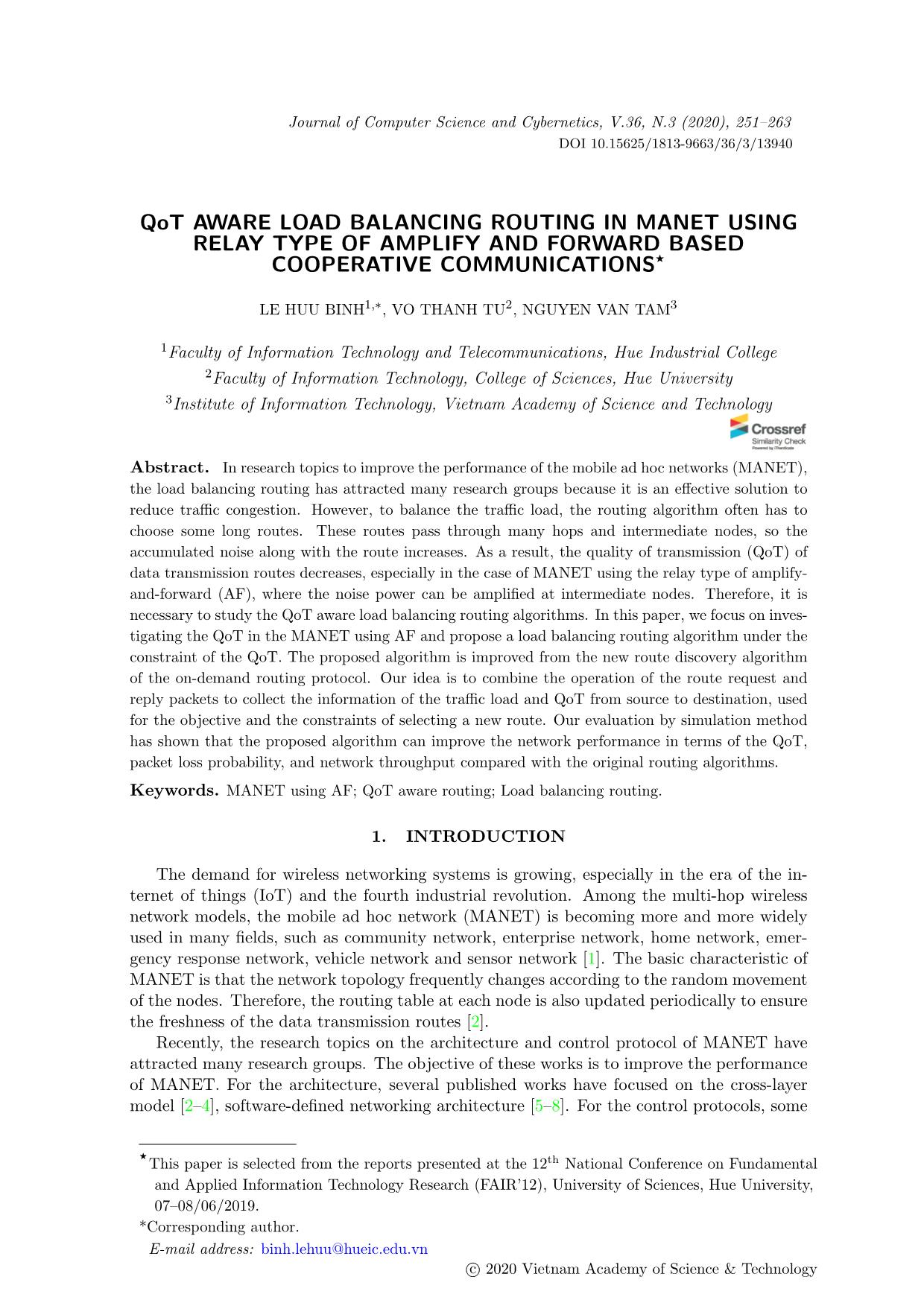
Trang 1
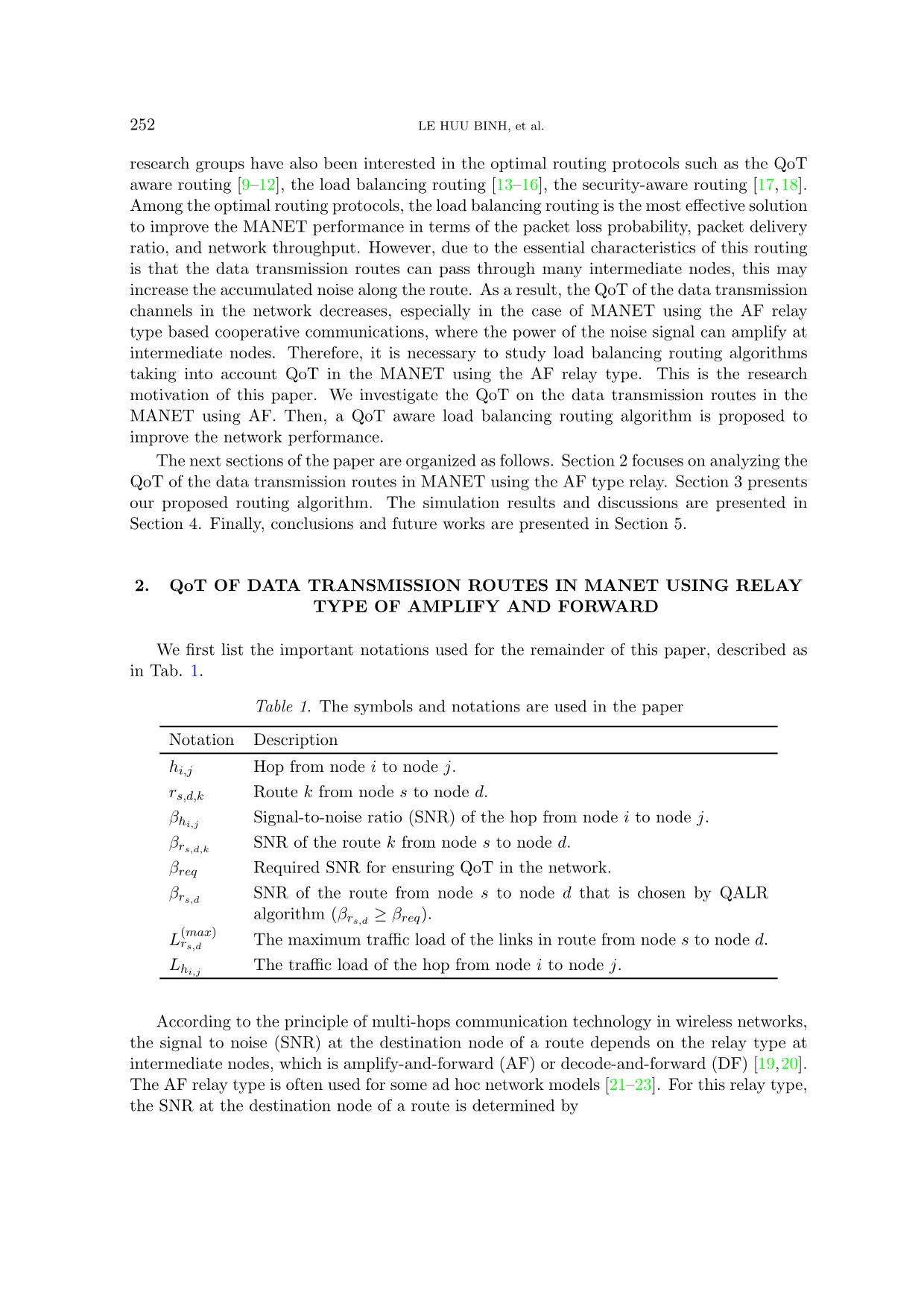
Trang 2
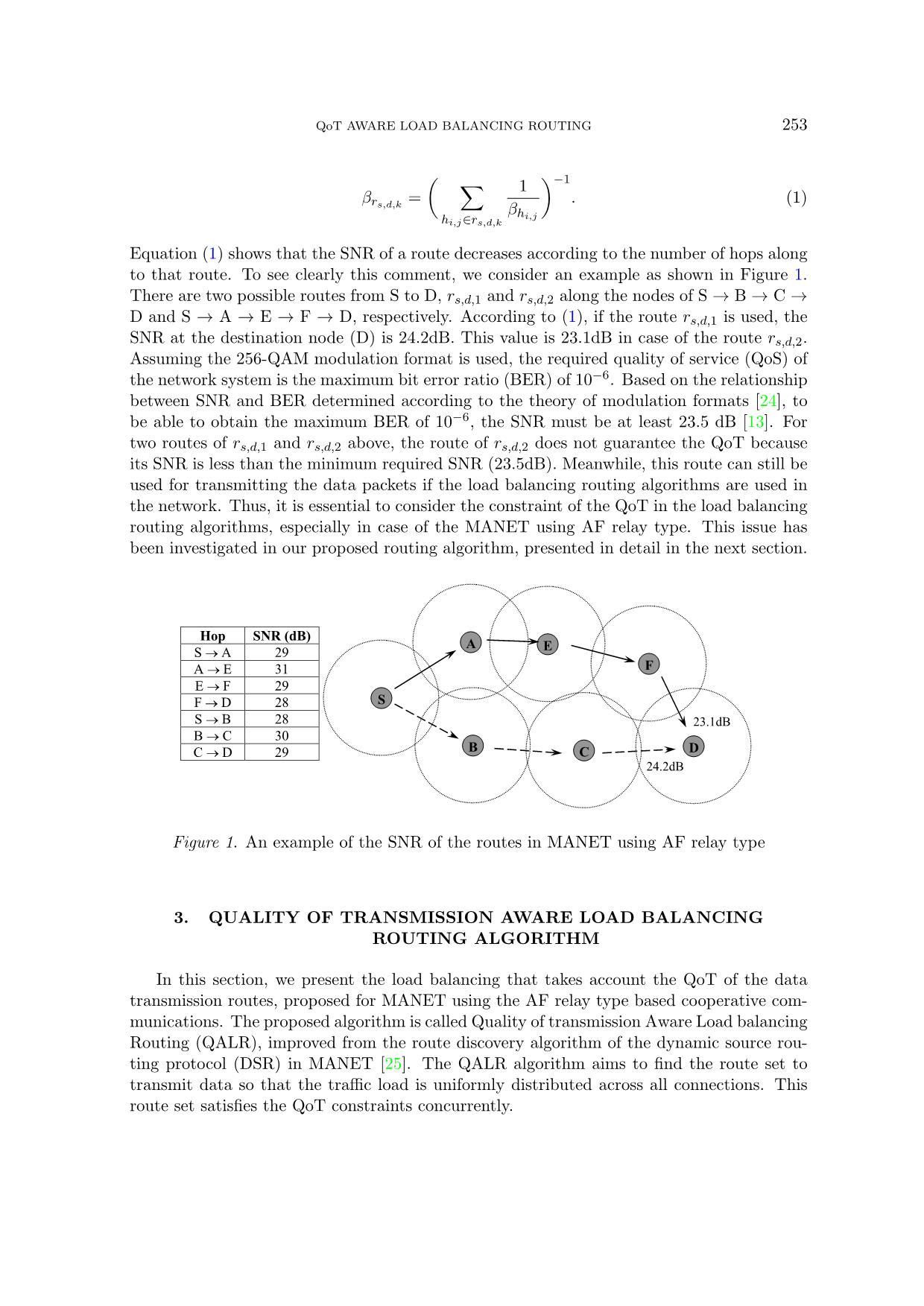
Trang 3
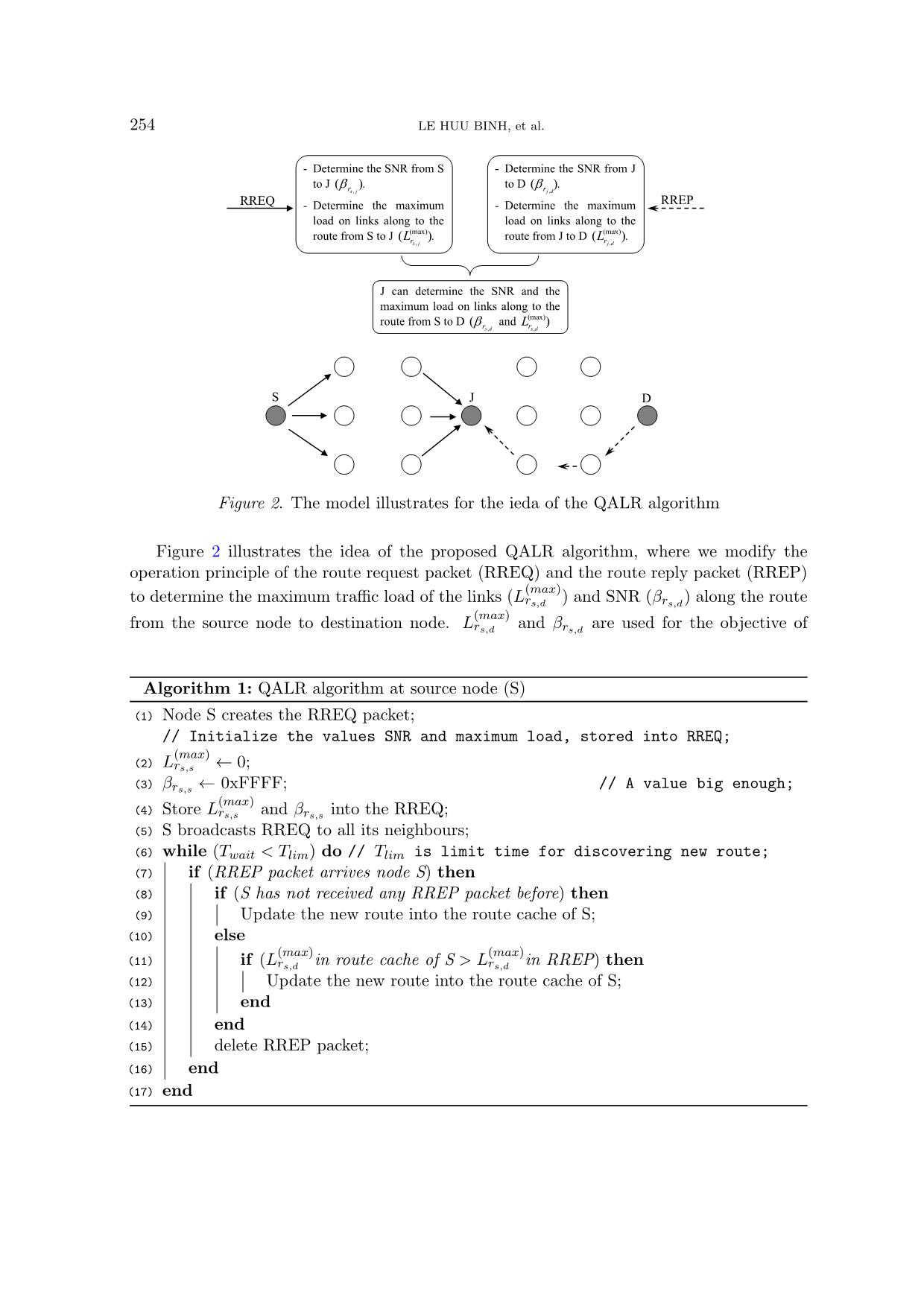
Trang 4
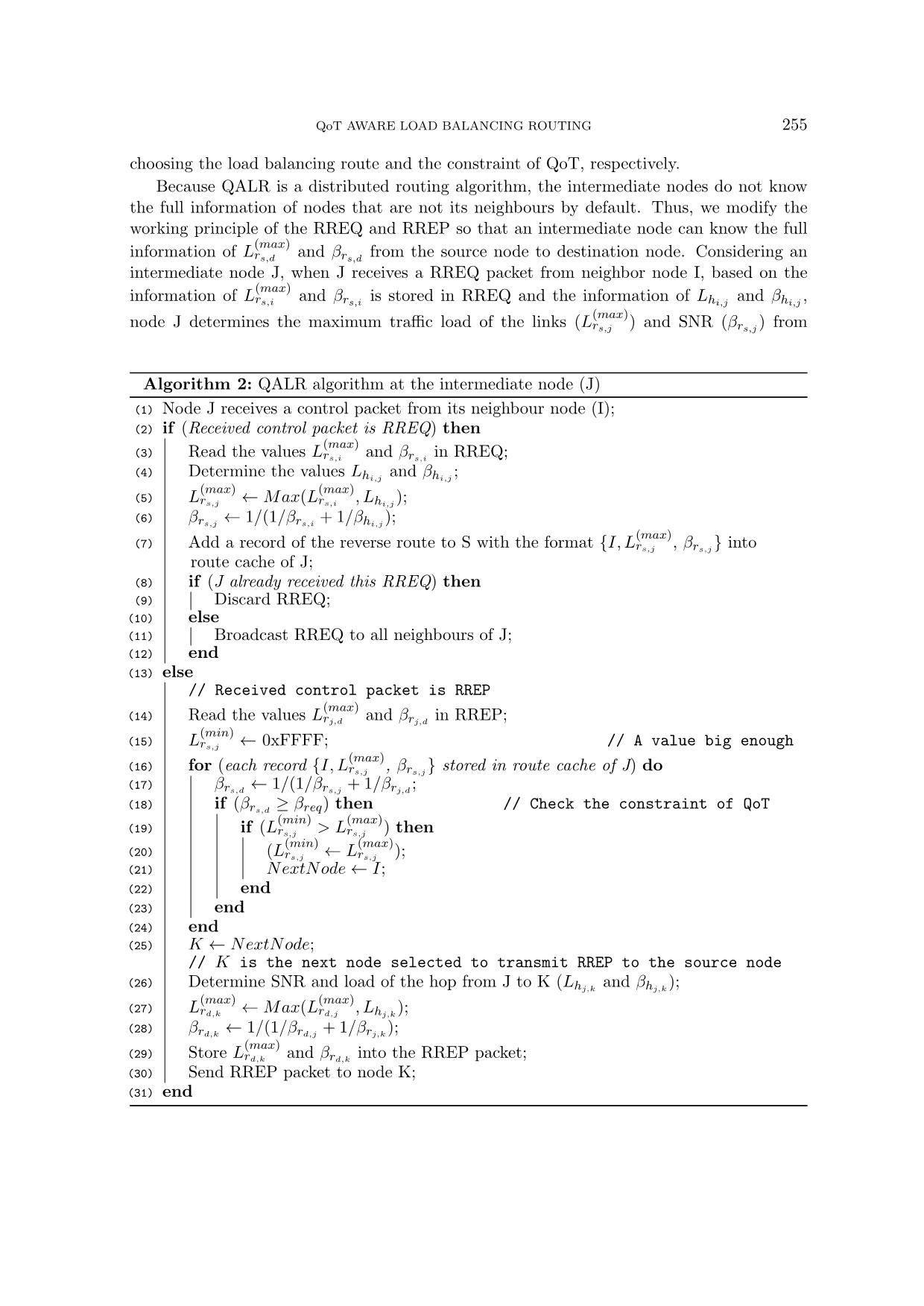
Trang 5

Trang 6
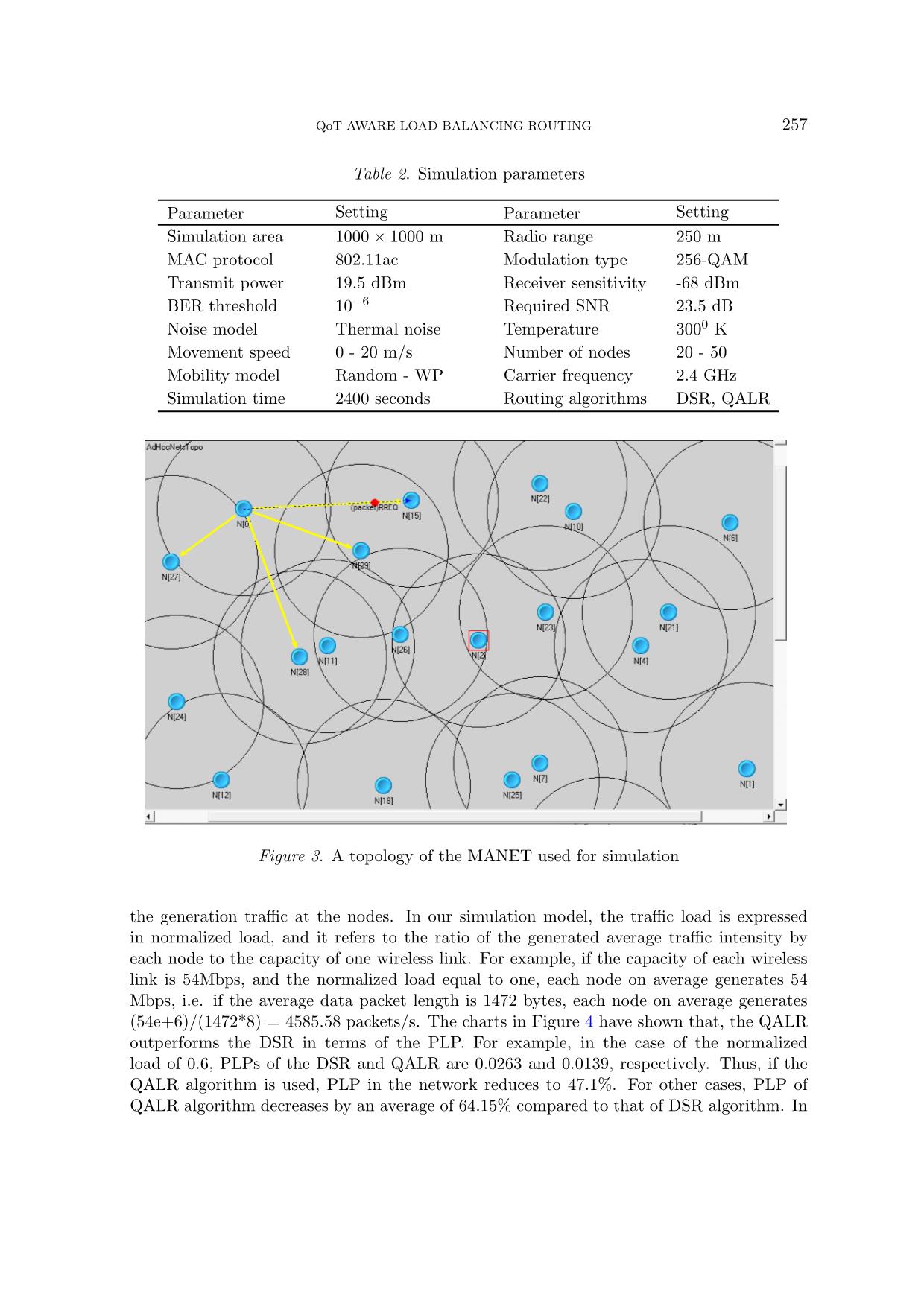
Trang 7
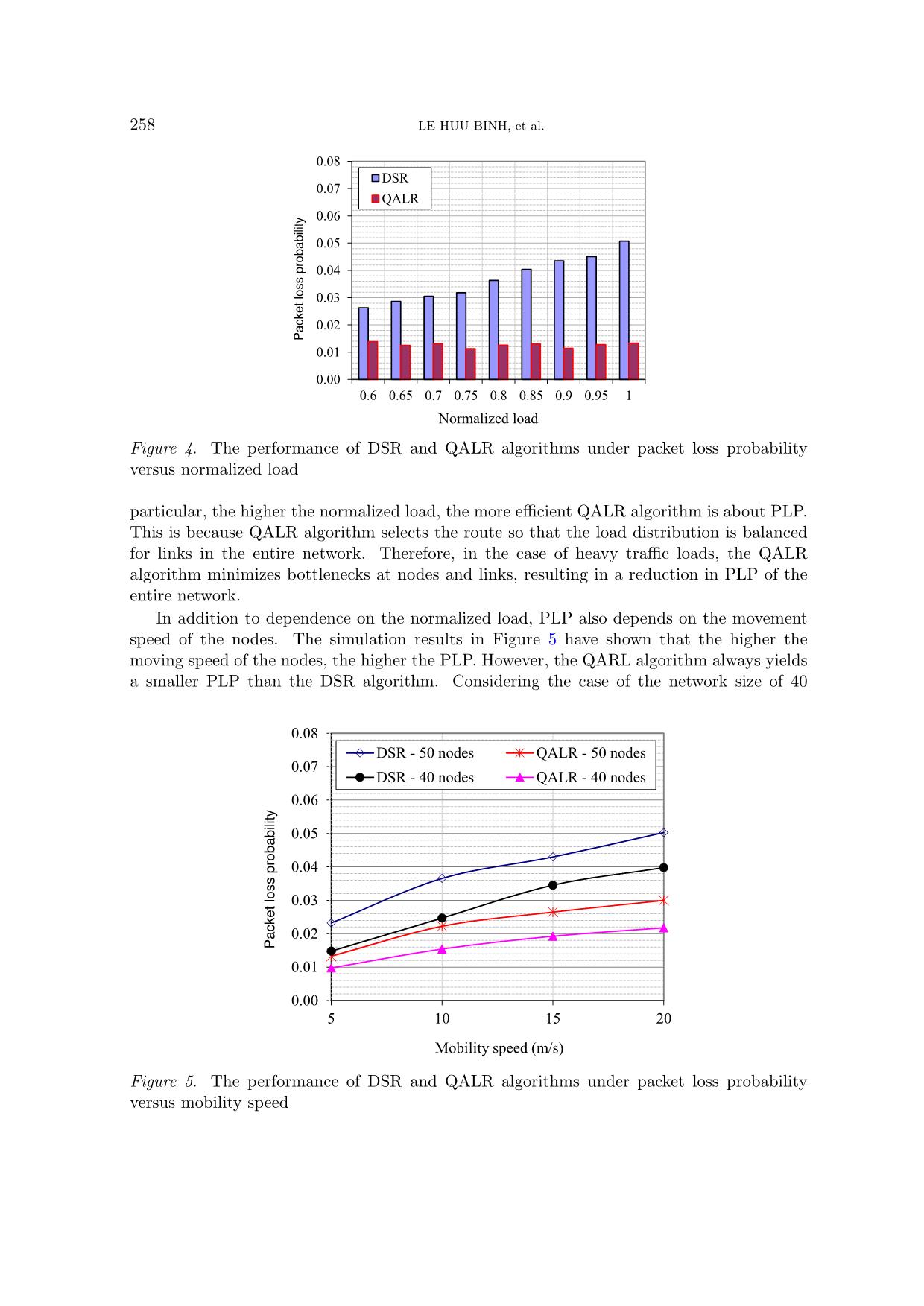
Trang 8
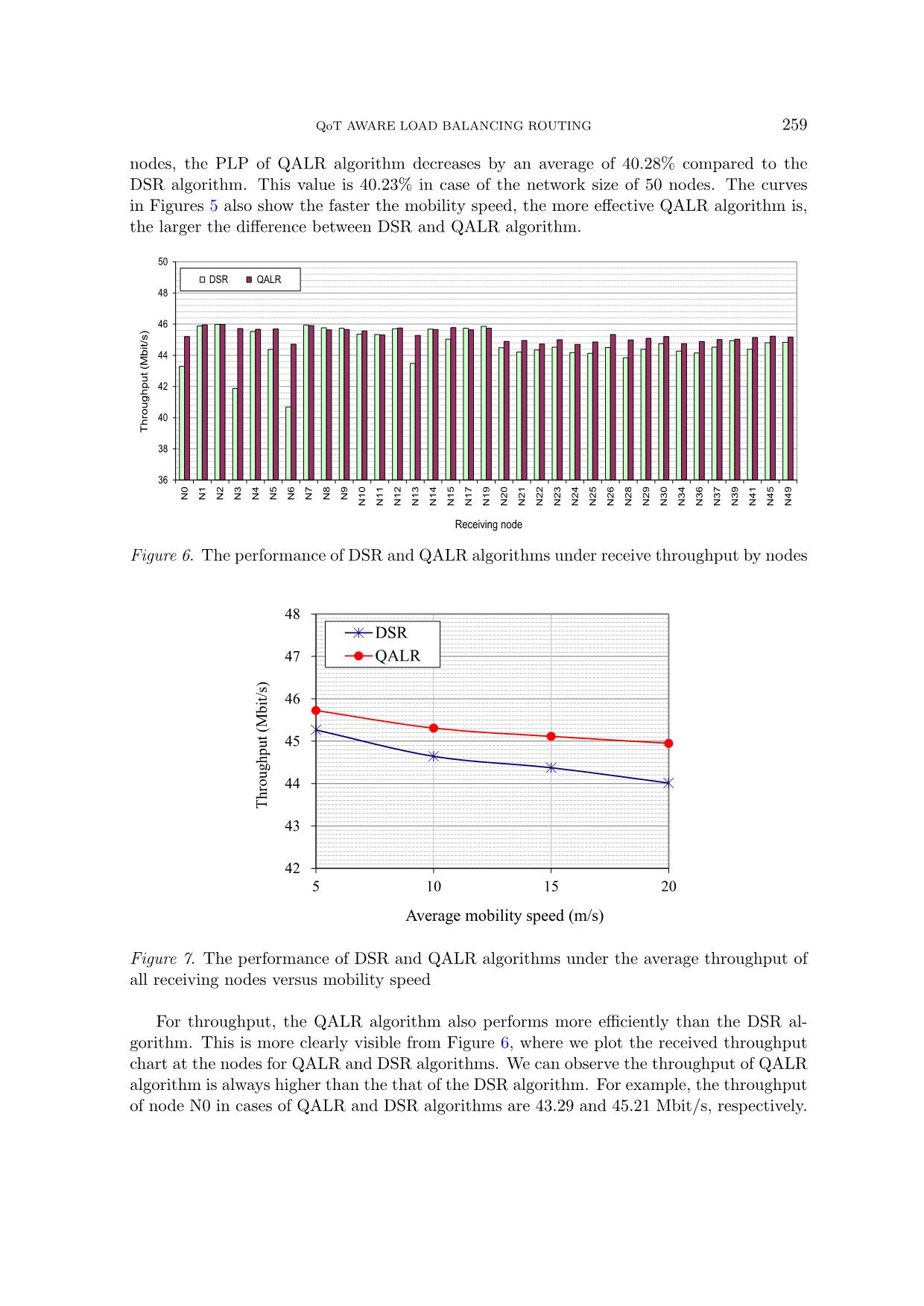
Trang 9
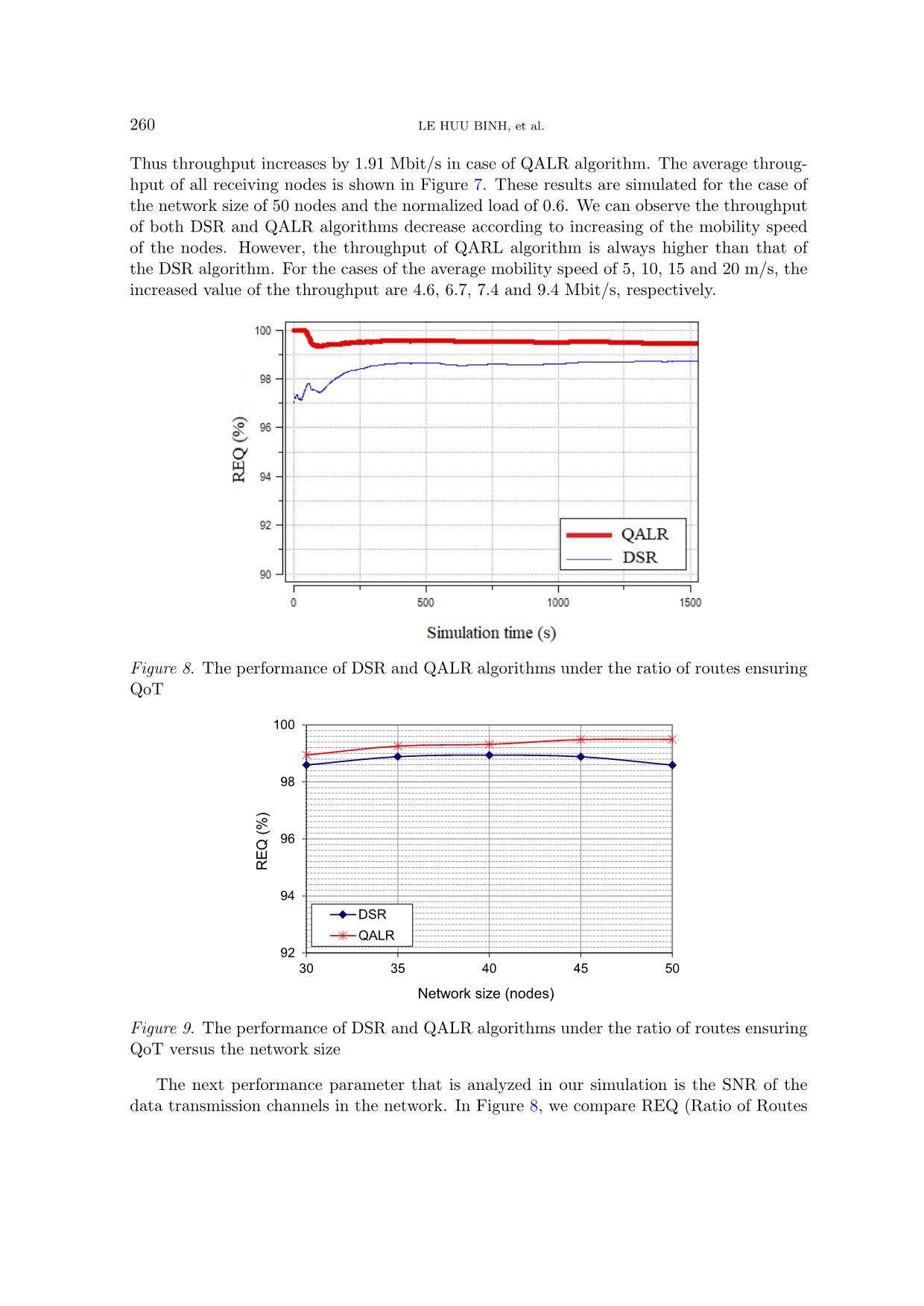
Trang 10
Tải về để xem bản đầy đủ
Tóm tắt nội dung tài liệu: QoT aware load balancing routing in manet using relay type of amplify and forward based cooperative communications
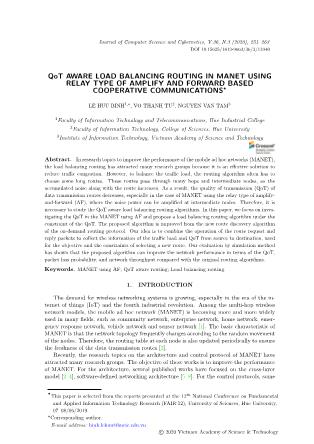
) if (βrs,d ≥ βreq) then (6) Determine traffic load of the hop from I to D (Lhi,d ); (max) (7) Lri,d ← Lhi,d ; (8) Create the RREP packet; (max) (9) Store Lri,d and βhi,d into the RREP packet; (10) Send RREP packet to source node I in order to reply to source node; (11) Discard RREQ; (12) else (13) Discard RREQ; (14) end 4. SIMULATION RESULTS AND DISCUSSION We have implemented the QALR algorithm in OMNeT++ [26] to evaluate its perfor- mance. The QALR algorithm is compared with the DSR algorithm [25] in terms of the SNR, packet loss probability, and network throughput. The simulation assumptions are set as in Table2. Figure3 shows a snapshot of the animation interface during the simulation performance, where node N[0] is broadcasting the RREQ to all its neighbours to discovery a new route. In Figure4, we analyze the data packet loss probability (PLP) in the overall network. PLP is an important performance parameter of the network system. In our context, PLP is determined as the ratio of the number of blocked packets to the number of generated packets during the entire simulation time. The charts in Figure4 have shown the difference in PLP versus traffic load in cases of using QALR and DSR algorithms. These results are simulated for the case that the number of nodes is 30, the average moving speed of each node is 20 m/s and the channel bandwidth of 40 MHz. Traffic load in Figure4 is the metric which denotes QoT AWARE LOAD BALANCING ROUTING 257 Table 2. Simulation parameters Parameter Setting Parameter Setting Simulation area 1000 × 1000 m Radio range 250 m MAC protocol 802.11ac Modulation type 256-QAM Transmit power 19.5 dBm Receiver sensitivity -68 dBm BER threshold 10−6 Required SNR 23.5 dB Noise model Thermal noise Temperature 3000 K Movement speed 0 - 20 m/s Number of nodes 20 - 50 Mobility model Random - WP Carrier frequency 2.4 GHz Simulation time 2400 seconds Routing algorithms DSR, QALR Figure 3. A topology of the MANET used for simulation the generation traffic at the nodes. In our simulation model, the traffic load is expressed in normalized load, and it refers to the ratio of the generated average traffic intensity by each node to the capacity of one wireless link. For example, if the capacity of each wireless link is 54Mbps, and the normalized load equal to one, each node on average generates 54 Mbps, i.e. if the average data packet length is 1472 bytes, each node on average generates (54e+6)/(1472*8) = 4585.58 packets/s. The charts in Figure4 have shown that, the QALR outperforms the DSR in terms of the PLP. For example, in the case of the normalized load of 0.6, PLPs of the DSR and QALR are 0.0263 and 0.0139, respectively. Thus, if the QALR algorithm is used, PLP in the network reduces to 47.1%. For other cases, PLP of QALR algorithm decreases by an average of 64.15% compared to that of DSR algorithm. In 258 LE HUU BINH, et al. 0.08 DSR 0.07 QALR 0.06 0.05 0.04 0.03 0.02 Packet loss probability 0.01 0.00 0.6 0.65 0.7 0.75 0.8 0.85 0.9 0.95 1 Normalized load Figure 4. The performance of DSR and QALR algorithms under packet loss probability versus normalized load particular, the higher the normalized load, the more efficient QALR algorithm is about PLP. This is because QALR algorithm selects the route so that the load distribution is balanced for links in the entire network. Therefore, in the case of heavy traffic loads, the QALR algorithm minimizes bottlenecks at nodes and links, resulting in a reduction in PLP of the entire network. In addition to dependence on the normalized load, PLP also depends on the movement speed of the nodes. The simulation results in Figure5 have shown that the higher the moving speed of the nodes, the higher the PLP. However, the QARL algorithm always yields a smaller PLP than the DSR algorithm. Considering the case of the network size of 40 0.08 DSR - 50 nodes QALR - 50 nodes 0.07 ó DSR - 40 nodes QALR - 40 nodes 0.06 0.05 0.04 0.03 0.02 Packet loss probability 0.01 0.00 5 10 15 20 Mobility speed (m/s) Figure 5. The performance of DSR and QALR algorithms under packet loss probability versus mobility speed QoT AWARE LOAD BALANCING ROUTING 259 nodes, the PLP of QALR algorithm decreases by an average of 40.28% compared to the DSR algorithm. This value is 40.23% in case of the network size of 50 nodes. The curves in Figures5 also show the faster the mobility speed, the more effective QALR algorithm is, the larger the difference between DSR and QALR algorithm. 50 DSR QALR 48 46 44 42 40 Throughput (Mbit/s) Throughput 38 36 N0 N1 N2 N3 N4 N5 N6 N7 N8 N9 N10 N11 N12 N13 N14 N15 N17 N19 N20 N21 N22 N23 N24 N25 N26 N28 N29 N30 N34 N36 N37 N39 N41 N45 N49 Receiving node Figure 6. The performance of DSR and QALR algorithms under receive throughput by nodes 48 DSR 47 QALR 46 bit/s) M ( 45 roughput 44 Th 43 42 5 10 15 20 Average mobility speed (m/s) Figure 7. The performance of DSR and QALR algorithms under the average throughput of all receiving nodes versus mobility speed For throughput, the QALR algorithm also performs more efficiently than the DSR al- gorithm. This is more clearly visible from Figure6, where we plot the received throughput chart at the nodes for QALR and DSR algorithms. We can observe the throughput of QALR algorithm is always higher than the that of the DSR algorithm. For example, the throughput of node N0 in cases of QALR and DSR algorithms are 43.29 and 45.21 Mbit/s, respectively. 260 LE HUU BINH, et al. Thus throughput increases by 1.91 Mbit/s in case of QALR algorithm. The average throug- hput of all receiving nodes is shown in Figure7. These results are simulated for the case of the network size of 50 nodes and the normalized load of 0.6. We can observe the throughput of both DSR and QALR algorithms decrease according to increasing of the mobility speed of the nodes. However, the throughput of QARL algorithm is always higher than that of the DSR algorithm. For the cases of the average mobility speed of 5, 10, 15 and 20 m/s, the increased value of the throughput are 4.6, 6.7, 7.4 and 9.4 Mbit/s, respectively. Figure 8. The performance of DSR and QALR algorithms under the ratio of routes ensuring QoT 100 98 96 REQ (%) REQ 94 DSR QALR 92 30 35 40 45 50 Network size (nodes) Figure 9. The performance of DSR and QALR algorithms under the ratio of routes ensuring QoT versus the network size The next performance parameter that is analyzed in our simulation is the SNR of the data transmission channels in the network. In Figure8, we compare REQ (Ratio of Routes QoT AWARE LOAD BALANCING ROUTING 261 Ensuring QoT) in cases of using DSR and QALR algorithms. In our context, REQ is defined as follows N REQ = E , (2) NA where NE is the number of routes ensuring QoT, i.e. the routes that its SNR is greater than required SNR. NA is the number of routes in the network. The curves in Figure8 have shown the QALR algorithm outperforms the DSR algorithm in term of the REQ. The average REQ of the DSR and QALR are 98.59% and 99.49%, respectively. Thus, the average REQ increases by 0.9% if comparing with DSR algorithm. In the case of the variable network size, The average REQs of both DSR and QALR are shown in Figure9. When the number of nodes changes from 30 to 50 nodes, REQ of the DSR and QALR are from 98.59% to 98.88% and from 98.94% to 99.4%, respectively. Thus, QALR algorithm always yields REQ higher than DSR algorithm. The reason for this is that QALR algorithm has considered the QoT constraint condition during route discovery, so the found routes always satisfy the QoT constraint condition. From the simulation results presented above, we can conclude the proposed QALR al- gorithm has found the load balancing routes, and these routes concurrently satisfy the QoT constraint conditions. As a result, network performance is significantly improved in terms of QoT, packet loss probability, and network throughput. In particular, QALR algorithm is highly efficient in the case of the heavy traffic load because the load balancing technique has been applied in this algorithm. 5. CONCLUSIONS In mobile ad hoc networks, the load balancing routing is one of the most effective solutions to improve its performance in terms of the packet loss probability and network throughput. The main reason for this is that the load traffic is distributed evenly for all links in the network. However, in the case of the MANET using the relay type of amplify-and-forward (AF) based cooperative communications, the load balancing routing can reduce the QoT since the routes can pass through multiple hops, and the power of the noise signal can amplify at intermediate nodes. In this paper, we proposed a routing algorithm for MANET using AF that takes into account both load balancing and QoT. Our proposed algorithm is improved from route recovery algorithm of DSR protocol, called QALR. The performance of QALR algorithm is investigated by the simulation method using OMNeT++. The simulation results have shown that the proposed algorithm can improve the network performance in terms of QoT, packet loss probability, and throughput compared with DSR algorithm. In the future, we continue to investigate the QoT of MANET using AF in cases of using the other routing protocols such as Ad hoc On-Demand Distance Vector (AODV), Destination-Sequenced Distance-Vector Routing (DSDV). REFERENCES [1] S. K. Sarkar, T. G. Basavaraju, and C. Puttamadappa, Ad Hoc Mobile Wireless Networks - Principles, Protocols, and Applications. Taylor & Francis Group, LLC, 2008. 262 LE HUU BINH, et al. [2] L. H. Binh, V. T. Tu, and N. V. Tam, “Quality of transmission aware routing in adhoc networks based on cross-layer model combined with the static agent,” Journal of Computer Science and Cybernetics, vol. 32, no. 4, pp. 351–366, 2016. [3] A. Yadav and T. Sharma, “Cross-layer approach for communication in MANET,” International Journal of Computer Science and Mobile Computing, vol. 4, pp. 285–292, March 2015. [4] M. M. zoulikha and B. Amal, “Cross-layer approach among physical, MAC and routing layer in a shadowing environment,” Ad-Hoc and Sensor Wireless Networks, vol. 21, no. 1-2, pp. 101–119, 2014. [5] A. J. Kadhim, S. A. H. Seno, and R. A. Shihab, “Routing protocol for SDN-Cluster based MANET,” Journal of Theoretical and Applied Information Technology, vol. 96, no. 16, p. 5, 2018. [6] A. Taha, R. Alsaqour, M. Uddin, M. Abdelhaq, and T. Saba, “Energy efficient multipath routing protocol for mobile Ad-Hoc network using the fitness function,” IEEE Access, vol. 5, pp. 10369– 10381, 2017. [7] S. Mora and J. Vera, “RDSNET: A proposal for control architecture for software defined MA- NETs,” International Journal of Engineering and Technology (IJET), vol. 10, no. 3, pp. 816–827, 2018. [8] D. Baihong, W. Weigang, Y. Zhiwei, and L. Junjie, “Software defined networking based on- demand routing protocol in vehicle ad-hoc networks,” ZTE Communications, vol. 15, no. 2, pp. 11–18, 2017. [9] F. Alnajjar and Y. Chen, “SNR/RP aware routing algorithm: Cross-layer design for MANETs,” International Journal of Wireless and Mobile Networks (IJWMN), vol. 1, no. 2, pp. 127–136, 2009. [10] L. H. Binh and V. T. Tu, “QTA-AODV: An improved routing algorithm to guarantee quality of transmission for mobile Ad Hoc networks using cross-layer model,” Journal of Communications, vol. 13, no. 7, pp. 338–349, 2018. [11] Istikmal, A. Kurniawan, and Hendrawan, “Selective route based on SNR with cross-layer scheme in wireless Ad Hoc network,” Journal of Computer Networks and Communications, vol. 2017, pp. 1–13, 2017. [12] M. Elshaikh, O. B. Lynn, M. N. bin Mohd Warip, P. L. Ehkan, F. F. Zakaria, and N. Yakoob, “SNR-based dynamic MANET on demand routing protocol for VANET networks,” ARPN Jour- nal of Engineering and Applied Sciences, vol. 10, no. 2, pp. 1099–1105, 2015. [13] L. H. Binh, V. T. Tu, and N. V. Tam, “SLBQT-DSR: Source-based load balancing routing algorithm under constraints of quality of transmision for MANET,” Journal of Computer Science and Cybernetics, vol. 34, no. 3, pp. 265–282, 2018. [14] K. J. Dsouza and S. M, “MRA: Multi-level routing algorithm to balance the traffic load in wireless Ad Hoc network,” in Proceedings of National Conference on Parallel Computing Technologies (PARCOMPTECH), pp. 1–5, Feb 2015. [15] L. K. Malviya and D. Tiwari, “LMP-DSR: Load balanced multi-path dynamic source routing protocol for mobile Ad-Hoc network,” in Proceedings of Fourth International Conference on Computing, Communications and Networking Technologies (ICCCNT), pp. 1–5, July 2013. QoT AWARE LOAD BALANCING ROUTING 263 [16] S. V. Mallapur, S. R. Patil, and J. V. Agarkhed, “Load balancing technique for congestion control multipath routing protocol in MANETs,” Wireless Personal Communications, vol. 92, no. 2, pp. 749–770, 2017. [17] L. T. Ngoc, V. T. Tu, and D. Hoang, “FAPRP: A machine learning approach to flooding attacks prevention routing protocol in mobile Ad Hoc networks,” Wireless Communications and Mobile Computing, vol. 2019, Article ID 6869307. [18] L. T. Ngoc and V. T. Tu, “A novel algorithm based on trust authentication mechanisms to detect and prevent malicious nodes in mobile Ad Hoc network,” Journal of Computer Science and Cybernetics, vol. 33, no. 4, pp. 357–378, 2017. [19] S. Khan, A.-S. K. Pathan, and N. A. Alrajeh, Wireless Sensor Networks - Current Status and Future Trends. CRC Press, 2012. [20] A.-S. K. Pathan, M. M. Monowar, and S. Khan, Simulation Technologies in Networking and Communications - Selecting the Best Tool for the Test. CRC Press, Taylor & Francis Group, LLC, 2015. [21] A. R. Nigara, M. Qin, and R. S. Blum, “On the performance of wireless Ad Hoc networks using amplify-and-forward cooperative diversity,” IEEE Transactions On Wireless Communications, vol. 5, no. 11, pp. 3204–3214, 2006. [22] A. Pandey and S. Yadav, “Performance evaluation of amplify-and-forward relaying cooperative vehicular networks under physical layer security,” Transactions on Emerging Telecommunications Technologies, pp. 1–18, 2018. [23] J. Lee, H. Shin, J. T. Kim, and J. Heo, “Transmission capacity for dual-hop relaying in wireless ad hoc networks,” EURASIP Journal on Wireless Communications and Networking, vol. 58, pp. 1–10, 2012. [24] A. Goldsmith, Wireless Communications. Cambridge University Press, 2005. [25] D. Johnson, Y. Hu, and D. Maltz, “The dynamic source routing protocol (DSR) for mobile Ad Hoc networks for IPv4,” RFC4728. [Online]. Available: rfc4728.txt. [26] A. Varga, OMNeT++ discrete event simulation system, release 4.6. 2015. [Online]. Available: Received on July 13, 2019 Revised on July 28, 2020
File đính kèm:
 qot_aware_load_balancing_routing_in_manet_using_relay_type_o.pdf
qot_aware_load_balancing_routing_in_manet_using_relay_type_o.pdf

